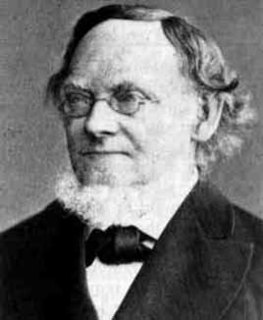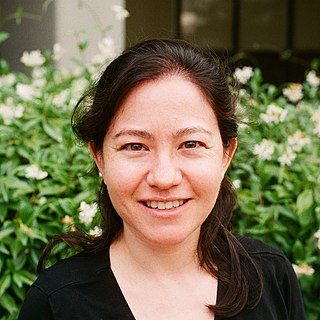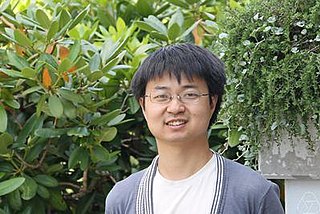
Hermann Günther Grassmann was a German polymath, known in his day as a linguist and now also as a mathematician. He was also a physicist, general scholar, and publisher. His mathematical work was little noted until he was in his sixties.

In mathematics, the general linear group of degree n is the set of n×n invertible matrices, together with the operation of ordinary matrix multiplication. This forms a group, because the product of two invertible matrices is again invertible, and the inverse of an invertible matrix is invertible, with identity matrix as the identity element of the group. The group is so named because the columns of an invertible matrix are linearly independent, hence the vectors/points they define are in general linear position, and matrices in the general linear group take points in general linear position to points in general linear position.

Algebraic varieties are the central objects of study in algebraic geometry, a sub-field of mathematics. Classically, an algebraic variety is defined as the set of solutions of a system of polynomial equations over the real or complex numbers. Modern definitions generalize this concept in several different ways, while attempting to preserve the geometric intuition behind the original definition.
The concept of supergroup is a generalization of that of group. In other words, every supergroup carries a natural group structure, but there may be more than one way to structure a given group as a supergroup. A supergroup is like a Lie group in that there is a well defined notion of smooth function defined on them. However the functions may have even and odd parts. Moreover, a supergroup has a super Lie algebra which plays a role similar to that of a Lie algebra for Lie groups in that they determine most of the representation theory and which is the starting point for classification.
In mathematics, Lie group decompositions are used to analyse the structure of Lie groups and associated objects, by showing how they are built up out of subgroups. They are essential technical tools in the representation theory of Lie groups and Lie algebras; they can also be used to study the algebraic topology of such groups and associated homogeneous spaces. Since the use of Lie group methods became one of the standard techniques in twentieth century mathematics, many phenomena can now be referred back to decompositions.
In mathematics, the GrassmannianGr(k, V) is a space that parameterizes all k-dimensional linear subspaces of the n-dimensional vector space V. For example, the Grassmannian Gr(1, V) is the space of lines through the origin in V, so it is the same as the projective space of one dimension lower than V.
Superspace is the coordinate space of a theory exhibiting supersymmetry. In such a formulation, along with ordinary space dimensions x, y, z, ..., there are also "anticommuting" dimensions whose coordinates are labeled in Grassmann numbers rather than real numbers. The ordinary space dimensions correspond to bosonic degrees of freedom, the anticommuting dimensions to fermionic degrees of freedom.
In mathematics, the Plücker map embeds the Grassmannian , whose elements are k-dimensional subspaces of an n-dimensional vector space V, in a projective space, thereby realizing it as an algebraic variety. More precisely, the Plücker map embeds into the projectivization of the -th exterior power of . The image is algebraic, consisting of the intersection of a number of quadrics defined by the Plücker relations.
In mathematics, particularly in the field of algebraic geometry, a Chow variety is an algebraic variety whose points correspond to effective algebraic cycles of fixed dimension and degree on a given projective space. More precisely, the Chow variety is the fine moduli variety parametrizing all effective algebraic cycles of dimension and degree in .
In mathematics, the tautological bundle is a vector bundle occurring over a Grassmannian in a natural tautological way: for a Grassmannian of -dimensional subspaces of , given a point in the Grassmannian corresponding to a -dimensional vector subspace , the fiber over is the subspace itself. In the case of projective space the tautological bundle is known as the tautological line bundle.
In mathematical physics, a Grassmann number, named after Hermann Grassmann, is an element of the exterior algebra over the complex numbers. The special case of a 1-dimensional algebra is known as a dual number. Grassmann numbers saw an early use in physics to express a path integral representation for fermionic fields, although they are now widely used as a foundation for superspace, on which supersymmetry is constructed.
In algebraic geometry, a Schubert variety is a certain subvariety of a Grassmannian, usually with singular points. Like a Grassmannian, it is a kind of moduli space, whose points correspond to certain kinds of subspaces V, specified using linear algebra, inside a fixed vector subspace W. Here W may be a vector space over an arbitrary field, though most commonly over the complex numbers.
In mathematics, the affine Grassmannian of an algebraic group G over a field k is an ind-scheme—a colimit of finite-dimensional schemes—which can be thought of as a flag variety for the loop group G(k ) and which describes the representation theory of the Langlands dual group LG through what is known as the geometric Satake correspondence.
In mathematics, a Grassmannian may refer to:
In algebraic geometry, determinantal varieties are spaces of matrices with a given upper bound on their ranks. Their significance comes from the fact that many examples in algebraic geometry are of this form, such as the Segre embedding of a product of two projective spaces.

Lauren Kiyomi Williams is an American mathematician known for her work on cluster algebras, tropical geometry, algebraic combinatorics, amplituhedra, and the positive Grassmannian. She is Dwight Parker Robinson Professor of Mathematics at Harvard University.
In algebraic geometry, the Grassmann d-plane bundle of a vector bundle E on an algebraic scheme X is a scheme over X:

Xinwen Zhu is a Chinese mathematician and professor at the California Institute of Technology. His work deals primarily with geometric representation theory and in particular the Langlands program, tying number theory to algebraic geometry and quantum physics.
In mathematics, especially in representation theory and algebraic geometry, the Beilinson–Bernstein localization theorem relates D-modules on flag varieties G/B to representations of the Lie algebra attached to a reductive group G. It was introduced by Beilinson & Bernstein (1981).